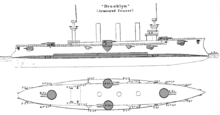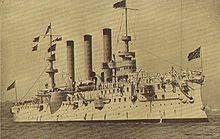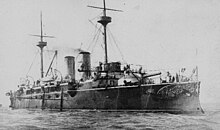USS Brooklyn (CA-3)
|
The USS Brooklyn (around 1907)
|
||||||||||||||||||||||
|
||||||||||||||||||||||
|
||||||||||||||||||||||
|
||||||||||||||||||||||
|
||||||||||||||||||||||
The USS Brooklyn (CA-3) was an armored cruiser of the United States Navy . The ship was named after the New York borough of Brooklyn and was the second ship in the American Navy to be baptized with this name. The cruiser, the construction of which was approved on July 19, 1892, was laid down on August 2, 1893 at the shipyard of the William Cramp & Sons Shipbuilding Company in Philadelphia , Pennsylvania , and launched on October 2, 1895 . The USS Brooklyn was a single ship and at the same time the second armored cruiser ever to be built by the United States Navy. The commissioning took place on December 1, 1896.
Technology and armament
The Brooklyn measured from bow to aft 122.71 m and was 19.71 meters wide. The ship was powered by twelve coal-fired Belleville water tube boilers (from 1909 there were only seven boilers on board) and four vertically installed triple expansion engines that controlled two propeller shafts. Although this configuration allowed a high speed, the control of one screw shaft each by two machines also entailed a certain complexity, since both machines had to be precisely coordinated with one another. This fact later caused problems with a hasty or insufficient coordination of the machines. The Brooklyn lost part of its speed during the sea battle of Santiago de Cuba because in the heat of the moment it was not possible to properly couple the two foremost triple expansion planes. As a result, the ship only reached a maximum speed of about 17 knots in this battle.
Usually the ship had a supply of coal of 900 tons on board (although the bunker capacity would have allowed up to 1,461 tons). The machine system exceeded the originally planned output (16,000 PSi ) by around 17 percent and ultimately produced 18,769 PSi. During the first speed tests on August 27, 1896 near Cape Ann (US state Massachusetts ), the cruiser reached a top speed of 21.91 kn (41 km / h), which meant that the ship exceeded the maximum speed of 20 kn planned by the shipyard . The Brooklyn was thus one of the fastest armored cruisers of the time.
The main artillery consisted of eight 203 mm L / 35 Mark 3 guns. These guns were installed in four Mark 8 twin turrets , with one turret each in front and aft of the superstructure and one turret each on the starboard and port side ( approximately level between the middle and the rearmost chimney). Six guns could be used with one broadside . In order to allow the guns standing on the sides a good firing range to the front and aft, the sides of the ship were also built to be inclined sharply inward ( tumble home design ). The 203 mm guns had a maximum range of around 14.6 km (although at the time they seldom shot over distances of more than 6 to 7 km) and fired an armor-piercing shell weighing 118 kilograms. A special feature was that two turrets were powered electrically and two with steam pressure for test purposes. In tests in March 1896, the electric drive proved to be far more reliable and was subsequently adopted as a result.
The middle artillery consisted of twelve 127 mm L / 40 Mark 3 guns in individual casemates (six each on both sides of the ship) and twelve lighter 57 mm Hotchkiss cannons (6 pounders) in individual installation. In addition, there were four 37 mm Maxim Nordenfeldt machine guns (1 pounder L / 42.5 Mark 6) on board. These guns fired around 25 rounds per minute and had a range of around 4,100 m. Furthermore, the ship was armed with four 457 mm torpedo tubes of the Whitehead type built rigidly and above the waterline , with two tubes each able to fire to starboard and to port. In addition, there were (stored below deck) four Gatling cannons and two 76 mm field guns on board, which were to be used on land missions.
Compared to other armored cruisers of the time, the Brooklyn was relatively lightly armored. This was a concession to the relatively high speed and the comparatively strong armament. The side armor was only 76 mm thick (for comparison: the maximum thickness of the side armor on armored cruisers built in Europe at the time was mostly between 152 mm, for example on the Russian cruiser Gromoboi , and around 200 mm, as on the German armored cruiser SMS Fürst Bismarck ).
Working time
After commissioning in December 1896, the cruiser made the first major representative trip abroad to the United Kingdom , where Queen Victoria celebrated her sixtieth anniversary to the throne in 1897 . The ship then returned to the US and carried out maneuvering and patrol missions in the Caribbean and off the US east coast .
Spanish-American War 1898
After the so-called Maine -Incident in the port of Havana in February 1898, which caused a massive deterioration of US-Spanish relations, which laid Brooklyn in March 1898 to the newly established so-called Flying Squadron of the US Navy after the West Indies and became flagship newly established this Association. The squadron consisted of the Brooklyn , the two ships of the line USS Massachusetts and USS Texas and the two armored cruisers USS Columbia and USS Minneapolis and was under the command of Commodore Winfield Scott Schley (on board the Brooklyn ).
After the Spanish-American War broke out at the end of April , Commodore Schley left Hampton Roads with the Brooklyn and the four other ships of his squadron as well as a coal ship in mid-May and began to blockade the port of Santiago de Cuba on May 29, 1898 . On May 31, the US association fired at the port facilities and the Spanish armored cruiser Cristóbal Colón lying in the port for the first time from a great distance . The shells fired at a distance of over 6,000 meters did little damage. In the port of Santiago de Cuba at this time, in addition to the Cristóbal Colón , the Spanish armored cruisers Vizcaya , Infanta Maria Teresa and Almirante Oquendo as well as two torpedo boats were lying . The Spanish association was under the command of Admiral Pascual Cervera . The Spanish Caribbean squadron, which on paper was quite strong, suffered from the poor quality of its coal (which slowed down the speed) and from a general inadequate maintenance. Numerous gun locks on board the ships were defective.
Also on May 31, Rear Admiral William Thomas Sampson , who arrived with the armored cruiser USS New York and two other ships of the line off Santiago de Cuba, assumed command of the now united US squadron.
The naval battle of Santiago de Cuba
On the morning of July 3, 1898, the Spanish fleet broke out of the port of Santiago de Cuba and tried to escape the superior US squadron on a westerly course along the coast. Immediately before the start of the battle, Commodore Schley had the Brooklyn perform a starboard turn in order to bring the flagship closer to the enemy. However, this unsettled maneuver , in ignorance of the course of the rest of the squadron, almost led to a collision with the ship of the line Texas , which could only avoid the collision by braking abruptly. As a result, the ship of the line fell behind the formation and was initially unable to intervene in the beginning battle. Schley later found himself exposed to severe criticism for this maneuver, despite the American success in the battle. Due to a coupling error, the crew of the Brooklyn was also unable to bring the ship to full speed, as the two front triple expansion engines could not be coordinated with the propeller shaft and the rear engines. This reduced the ship's top speed to around 17 knots in the initial phase of the battle. However, the armored cruiser was still faster than most Spanish ships.
In the course of the battle almost all Spanish ships were badly hit and had to land on the coast. The Brooklyn and the Spanish armored cruiser Vizcaya (under the command of Capitán de Navío Don Antonio Eulate ) fought a bitter artillery duel between themselves at a distance of only about 800 to 1,100 meters. While the Spanish ship received around 20 hits, the Brooklyn was only hit by four 140 mm shells (two of which were duds ) and a few lighter projectiles, which destroyed the front battle mast and a 127 mm gun on the starboard side out of action put. There was one dead and two wounded. Many of the Spanish shells turned out to be duds and only tore small holes in the superstructure or burst due to the poor quality of the projectiles on the armor protection, which is why the US ship remained largely ready for action and did not suffer any damage to vital parts. In return, however , the Brooklyn scored two heavy 203 mm hits on the Vizcaya at around 11 a.m. , which triggered a violent subsequent explosion in the bow (because a charged torpedo tube had been hit). The Spanish ship then dropped the flag at around 11:06 a.m. and burned aground on the shore about 18 nautical miles west of Santiago de Cuba.
The bulk of the Spanish squadron was thus destroyed in the first two hours of the battle. The fast armored cruiser Cristóbal Colón alone was able to break away from the enemy and gain a lead. The fastest U.S. ships, including the Brooklyn (suffering from engine problems) , the battleship New York and the liner Oregon , took up chase, scoring at least six hits (including one from a 203mm shell) over the course of two hours the Cristóbal Colón . After a hunt lasting about 50 nautical miles, the burning ship finally had to land on the coast and was abandoned by the crew. The sea battle off Santiago de Cuba came to an end. In total, the Brooklyn had received about 20 hits during the four-hour fight, mostly from light or medium guns. There had been one dead (the only American fallen in the battle) and two wounded on board.
The ship then stayed off the Cuban coast and again shelled the port of Santiago de Cuba on July 10th. The Spanish garrison, besieged from the land side, finally capitulated on July 17, 1898. After the end of the Spanish-American war in August 1898, the armored cruiser moved to New York , where the minor battle damage was repaired.
Period of use from 1899 to 1908
After participating in the celebrations on the occasion of the American victory in the Spanish-American War in New York on October 5, 1898, the Brooklyn moved through the Suez Canal to the Philippines in 1899 and became the flagship of the American Asian squadron there from December. In the summer and autumn of 1900, the ship took part in the intervention of the so-called United Eight States in China on the occasion of the Boxer Riots . The cruiser then visited New Zealand and Australia . From March 1902 the Brooklyn was ordered back to the United States.
Between 1902 and 1907 several trips followed, mostly for maneuvers and representation purposes, to the Caribbean, the Mediterranean and Europe. The was Brooklyn also part of the occasion of Perdicaris Incident emitted naval squadron and transported in June 1905, the remains of 1792 in Paris late American naval hero and independence fighter John Paul Jones from France to the USA, where they in the United States Naval Academy were buried . After a three-month layover as an exhibition ship at the world exhibition in Jamestown ( Jamestown Exposition ), the 300th anniversary of the founding of the city (as the first English settlement in the New World ) was also celebrated, the Brooklyn was in December 1907 in the Reserve shifted. Half a year later, on June 23, 1908, the ship was temporarily taken out of service.
Period of use from 1908 to 1921
Between 1908 and 1914, the Brooklyn was located in Philadelphia and served as a reserve and warehouse. Five of the boilers were expanded in 1909. It was not until 1914 that the ship was resumed and relocated to Boston , where the cruiser initially served as a reserve for the US Atlantic fleet (from May 2, 1914) . On May 9, 1915, the Brooklyn , under the command of Commodore Dudley W. Knox, was put back into service and drove fuse missions off the US east coast as part of the neutrality patrol. At the end of 1915 the ship moved to Asia and stayed there until September 1919, calling at Russian , Japanese and Chinese ports , among others . On December 9, 1918, a coal dust explosion occurred in a coal bunker, killing ten members of the machine personnel and coal diggers. After a short period of service as the command ship of the commander of the destroyer forces of the US Pacific Fleet 1920/21, the Brooklyn was finally decommissioned on March 9, 1921 at the Mare Island Naval Shipyard in California . Sold for demolition in December 1921, the Brooklyn was scrapped from 1922 onwards.
Individual evidence
- ↑ http://www.spanamwar.com/brooklyn.htm
- ↑ http://www.navweaps.com/Weapons/WNUS_8-35_mk3.htm
- ↑ http://www.spanamwar.com/brooklyn.htm
- ↑ Ibid.
- ↑ http://www.spanamwar.com/vizcaya.htm
- ↑ http://www.findagrave.com/cgi-bin/fg.cgi?page=gr&GRid=59931519
literature
- Ivan Musicant: US Armored Cruisers. A Design and Operational History. Naval Institute Press, Annapolis 1985.




